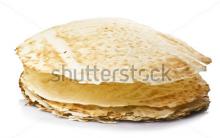To separate the components of the mixture by paper chromatography, a drop of the analyzed sample is placed on a strip of filter chromatographic paper 2-4 cm from the end of the strip, and the end of the strip is dipped into a solvent, which begins to move along the paper under the action of capillary forces. To prevent paper dehydration, the mobile phase is usually saturated with water. When the mobile phase moves, the components of the test sample, applied to paper near the start, are distributed between the moving solvent and the water film held by cellulose. In this case, the components move at different speeds in the form of zones, the size of which is usually somewhat larger than the size of the initial spot. Chromatography on paper is usually performed in a closed vessel (Fig. 1) to avoid solvent evaporation during chromatography. In ascending chromatography, the upper end of the paper strip is fixed in a holder and the lower end is dipped into a solvent that is poured into a low cuvette or Petri dish located at the bottom of the vessel in which the chromatography is performed. For these purposes, you can also use a large measuring cylinder, on the bottom of which the mobile phase is poured, and the top is covered with glass.
Figure: 1 - Chromatography on paper: A - ascending chromatogram; B - descending chromatogram; 1 - vessel for chromatography; 2 - solvent reservoir; 3 - chromatographic paper; 4 - starting points; 5 - separated components; 6 - solvent front
In descending chromatography, the solvent moves down the paper from the solvent reservoir at the top of the vessel. In this way, the individual components can be eluted.
The manifestation of paper chromatograms does not differ in principle from that described for thin-layer ones.
The efficiency of paper chromatography depends on both the paper type and the composition of the mobile phase. Paper grades differ in porosity, thickness, degree of hydration. According to the speed of movement, solvents distinguish between fast, medium and slow papers. The most common types of chromatographic papers are Leningrad, Whatman, etc.
The most common solvent systems: СН3СООН-Н2O (15:85 volume), 1-butanol - СН3СООН-Н20 (4: 1: 5), 2-propanol - NH3 (conc.) - Н2O (9: 1: 2), 1 -butanol - 1.5 N. NH3 (1: 1), phenol - water, etc. The composition of the mobile phase is usually selected experimentally or based on the data given in reference books or monographs on paper chromatography.
The use of ion exchange paper allows you to combine the advantages of paper chromatography and ion exchange. Such paper is made by mixing an ion exchange resin with cellulose used to make paper.
Paper chromatography is essential for qualitative analysis. Its use in quantitative analysis is limited.
MINISTRY OF HEALTH OF THE RUSSIAN FEDERATION
GENERAL PHARMACOPEY CLAUSE
ChromatographyOFS.1.2.1.2.0002.15
on paper Instead of Art. GFXI, issue 1
The chromatographic process that occurs on a sheet of filter paper while moving along its capillaries and the surface of the mobile phase is called paper chromatography.
The stationary phase is either the paper itself or the substances previously applied to its fibers. The mechanism of chromatography on paper can be distribution or adsorption. The movement of the mobile phase occurs either only under the action of capillary forces (ascending chromatography), or under the action of capillary forces and gravity (descending chromatography).
During chromatography, the analytes form adsorption zones on paper in the form of round or oval spots or stripes, depending on the method of application (dot or strip). The set of adsorption zones obtained by chromatography of a given sample to be analyzed is called a chromatogram.
The mobility of a substance during chromatography is characterized by a retention factor R f, (see).
Application area
Paper chromatography can be used to establish the identity, purity, and quantification of an analyte.
The authenticity is confirmed by simultaneous chromatography of the analyte and the reference substance on one sheet of paper. If the samples are identical, then the corresponding adsorption zones on the chromatograms have the same form and equal values R f. For identification, it is sometimes advisable to chromatograph a mixture of equal amounts of the analyte and the standard substance. The chromatogram should show one spot that characterizes the adsorption zone. The chromatographic conditions should be selected so that the values R f were different from 0 and did not exceed 1. In addition, to confirm the authenticity of the analyte, the specific conditions of its detection specified in the monograph can be used.
When tested for purity, impurities and base substances should have different values. R f. The degree of purity of the analyte can be judged by the magnitude and intensity of the color (or absorption) of the impurity adsorption zones found on the chromatogram. The content of impurities can be determined semi-quantitatively. For this, a certain amount of the analyte and several samples of the determined impurity (witness) with different, precisely known concentrations are simultaneously chromatographed on one sheet of paper. The content of impurities in the analyzed sample is estimated by comparing its adsorption zone on the chromatogram based on the aggregate of the adsorption zone area and color intensity (or absorption) with the adsorption zones of the witness.
For quantitative analysis, special devices are used that allow measurements in the ultraviolet and visible regions of the spectrum. For processing chromatograms in the visible region of the spectrum, it is advisable to use flatbed scanners and the corresponding software.
you can also quantify substances after extraction from the chromatogram. For this, the adsorption zones are cut out and the analyte is extracted with a suitable solvent. The content of the analyte in the extract or the dry residue after distillation of the solvent is found by any method suitable for determining low concentrations and taking into account the structure of the analyte.
A sample of the test mixture can be applied either pointwise to the start line, or in the form of a uniform strip along the entire start line, while the primary adsorption zone will look like a spot, and in the second case, a strip parallel to the start line.
Equipment
For chromatography on paper, sealed chambers are used, made of an inert material and allowing to observe the progress of the separation process with the chamber lid closed. Glass beakers or cylinders with a ground lid and additionally sealed are often used as chambers. The cover may have inlets (sluices) for adding solvent or relieving overpressure in the chamber.
For descending chromatography, a mobile phase vessel (boat) is placed on top of the chamber. The boat should have sufficient mobile phase volume to perform at least one chromatography. The boat must be longer than the width of the chromatographic paper. The chamber should be equipped with devices for fixing the chromatographic paper sheet in the working position and for introducing the mobile phase into the boat.
In ascending chromatography, the mobile phase is either placed in a boat installed in the lower part of the chamber, or poured into the bottom of the chamber.
The inner walls of the chamber are covered with filter paper, which contributes to its faster and more complete saturation with the vapors of the solvents that make up the mobile phase.
Preparation of equipment, chromatographic paper and mobile phase is given in monographs.
Chromatographic separation techniques
Paper chromatography can be one-dimensional or two-dimensional.
One-dimensional paper chromatography assumes spot application or application in the form of a strip of a sample of the studied mixture on the start line and subsequent chromatography in one direction (Fig. 1).
Figure 1 - Approximate scheme of one-dimensional paper chromatography
Two-dimensional chromatography assumes the sequential passage of the mobile phase in two perpendicular directions, which allows for a clearer separation of the mixture of analytes (Fig. 2).

Figure 2 - Approximate scheme of two-dimensional paper chromatography
Descending chromatography
A stationary or mobile phase is placed at the bottom of the chromatographic chamber in an amount sufficient to form a layer 2.5 cm deep. The chamber is closed and left to saturate for 24 hours at a constant temperature. In some cases, by using sufficiently volatile solvents, this time can be reduced.
The solutions of substances are applied to the start line with a micropipette or a microsyringe so that the distance between the points of application of individual samples is at least 3 cm.If the minimum amount of the analyzed solution required for chromatography can form a primary adsorption zone on paper in the form of a spot exceeding 10 mm in diameter , application is carried out in several steps, preventing excessive diffusion at the start line by drying. After applying the solutions of the analyzed substances and drying the resulting primary chromatogram, the paper strip is fixed in the working position in the chamber and left for 1.5 hours. In the working position, the chromatographic paper strip should hang vertically so that between its upper end immersed in the boat, and the starting line was only one, as smooth as possible, bend. At the end of the exposure, chromatography begins, for which a mobile phase is poured into the boat. Chromatography is usually completed when the mobile phase front approaches the lower end of the paper strip. If there are no special instructions in the monograph, the strip is removed from the chamber and dried in air, marking the final position of the front of the mobile phase with a graphite pencil. The adsorption zones are detected according to the instructions of the Pharmacopoeia Monograph.
Upstream chromatography
For ascending paper chromatography, chambers are used in which a vessel (boat) with a mobile phase is located at the bottom or at the bottom. A strip of chromatographic paper is fixed in the upper part of the chamber so that the lower end of the strip can be immersed in a boat with a mobile phase. In the working position of the strip, the start line should be 2 - 3 cm from the surface of the mobile phase. Otherwise, the methods of work when carrying out ascending chromatography on paper do not differ from those described above.
Phase and paper preparation
When preparing immiscible systems of solvents, jointly used in chromatography as mobile and stationary phases, it is necessary to ensure their mutual saturation, for example, by shaking in a separating funnel. In this case, the monograph should indicate which of the phases is used for chromatography.
The filter paper of the required density of qualification "for chromatography" is cut in a direction perpendicular or parallel to the fibers into sheets (strips), the length of which is approximately equal to the height of the chamber. The width of these strips can be approximately determined by the formula: AND = 3(TO+ 1), where AND - strip width (cm), TO - the number of chromatograms per strip.
On each strip of paper, a straight line, called the start line, is drawn with a graphite pencil to indicate the places of application of the chromatographed substances. The distance from the end of the strip of paper to the start line is chosen so that when the paper is immersed in the boat, direct contact of the substances applied to the start line with the liquid in the boat is excluded.
On the sheets of filter paper prepared in this way, if indicated in the monograph, the stationary phase is applied. To do this, the corresponding low-volatility solvents (formamide, propylene glycol, etc.) are mixed with volatile solvents and the sheets of paper to be processed are immersed in the resulting mixture for 1 - 2 s. The excess mixture is removed from the surface of the sheets by squeezing them between two layers of filter paper, after which the volatile component of the mixture is removed by drying in air for 15 - 20 minutes.
If an aqueous solution of non-volatile substances is recommended as the stationary phase, then the paper is treated with this solution, dried, as indicated above, and before chromatography it is kept in a chamber containing water vapor. The application of volatile components of the stationary phases to paper is carried out by keeping it in the vapor of the phase in the chamber immediately before chromatography.
Detection of adsorption zones
At the end of chromatography, the chromatograms are dried until traces of solvents are removed and viewed in visible or ultraviolet light (at a specific detector wavelength specified in the Pharmacopoeia Monograph), while noting the adsorption zones. In some cases, to detect adsorption zones, the chromatogram is treated with special reagents that form colored reaction products with the analytes by spraying or dipping into a reagent solution.
The method for detecting adsorption zones must be specified in the corresponding monograph for the medicinal product.
PAPER CHROMATOGRAPHY, a method of separation, identification and quantification of substances; one of the planar variants of liquid chromatography, in which special paper is used as the stationary phase or inert carrier of the stationary phase. The paper chromatography method was proposed by A. Martin and R. Sing in 1944 for the analysis of mixtures of amino acids.
The separation of the components of the mixture occurs due to the distribution of substances between the stationary phase and the mobile (eluent); uniform advancement of the eluent along the stationary phase layer is ensured by the capillary structure of the paper. The transfer of components by the eluent occurs at different rates in accordance with their distribution coefficient. As a result, substances form separate zones (spots) on the chromatogram, the position of which is characterized by the values \u200b\u200bof R f - the relative speed of movement. Experimentally, the value of R f is determined as the ratio of the distance traveled by the substance to the distance traveled during the same time by the eluent; R f ≤1; the value of R f depends on the nature of the substance, the composition of the mobile phase, the type of paper, the experimental technique and should not depend on the concentration of the analyte and the presence of other substances. The colored zones on the chromatogram are observed visually, the unstained ones are developed with reagents that form colored or fluorescent compounds with the components of the mixture to be separated. The identification of substances can be based on a comparison of the R f values \u200b\u200bof the test and standard solutions. Quantitative analysis is carried out directly on the chromatogram (by spot size, absorption or reflection spectra, using densitometry, radiometry, etc.) or after separation (for example, by extraction) of the substance of the chromatographic zone from the cellulose base (for determination, spectrophotometric, fluorometric, atomic absorption and other methods).
Paper chromatograms can be obtained by ascending, descending, or horizontal (radial) movement of the eluent; using repeated separation, two-dimensional chromatograms are obtained. The separation is carried out in closed chambers (glasses, cylinders, etc.) saturated with vapors of the mobile phase. To separate hydrophilic compounds, use a special chromatographic paper (made of cellulose fibers) containing water or ion exchangers as a stationary phase. To separate water-insoluble compounds, paper is hydrophobized by acetylation or impregnation with hydrophobic substances (paraffin, rubber, organic reagents, etc.). Various solvents or their mixtures, aqueous solutions of organic and inorganic acids, alcohols, electrolytes, etc. are used as eluents.
The paper chromatography method can be used to analyze small amounts (10 -9 -10 -6 g) of chemical compounds of almost all classes. Due to its technical simplicity and accessibility, paper chromatography is used when detecting easily separated substances, when checking the individuality of organic compounds, determining trace elements in geochemical analysis, etc.
Lit .: Chromatography on paper. M., 1962; Chromatography. Practical application of the method. M., 1986. T. 1-2; Fundamentals of Analytical Chemistry / Edited by Yu. A. Zolotov. 2nd ed. M., 1999. Book. 1.
Partition chromatography is based on the property of the components being separated to be differently distributed between two immiscible or slightly miscible liquid phases. One of the liquid phases is a stationary phase, it is firmly retained on the surface of a solid substance - "carrier" - in the form of a monomolecular layer of liquid. In another phase - mobile - the test mixture applied to the carrier is dissolved.
In the process of chromatography, the substances of the mixture are redistributed between two immiscible liquid phases. The speed of movement of individual components is different, which makes it possible to separate them from a complex mixture. In research practice, the most widely used method of distribution chromatography on paper.
Partition chromatography on paper. The carrier is air-dry filter paper, and the hygroscopic water contained in it is the stationary phase. Organic solvents which are immiscible or partially miscible with water are used as the mobile phase.
When obtaining chromatograms by the method of paper chromatography, a drop of the test solution is applied to the edge of a strip of filter paper, then the strip is immersed in a glass bath specially designed for chromatography containing a mobile solvent. When the solvent moves along the paper, the individual components of the mixture also move, but at different speeds, which ensures the separation of the mixture.
Chromatograms are obtained in sealed chambers in an atmosphere saturated with vapors of organic solvent and water. The obtained chromatograms are dried and for the development of the separated substances they are sprayed (developed) with a reagent, which forms colored compounds with the isolated substances, which makes it possible to determine their location on a strip of paper. Under certain experimental conditions, the distribution of individual substances in both liquid phases is characterized by a constant Rf coefficient.
The distribution coefficient Rf is defined as the ratio of the distance (in cm) traveled by the test solution to the distance (in cm) traveled by the solvent. The reproducibility of Rf values \u200b\u200bdepends on the conditions of the tests being carried out (paper quality, purity of solvents, temperature, composition of the gas atmosphere, etc.).
There are several options for paper chromatography: ascending - the solvent moves from bottom to top, descending - the solvent moves from top to bottom and radial (circular) - the solvent moves from the center to the circle. In addition, one-dimensional and two-dimensional chromatography is used; in one-dimensional chromatography, the separation of substances is carried out in one direction, in two-dimensional chromatography - in two mutually perpendicular directions.
One-dimensional chromatography. One-dimensional chromatography is the simplest and is used to study simple mixtures, to check the purity of a substance, to identify substances.
In one-dimensional chromatography, the determination procedure is as follows. A certain amount of the test solution is applied to a strip of chromatographic paper at a distance of several centimeters from the edge. The paper is placed in a solvent bath in the chamber using either ascending or descending chromatography (Figure 11). The solvent advances, and when about 2 cm remains until the end, the process is stopped, the chromatogram is removed from the chamber, the solvent front is noted and dried at a temperature of 100 ° C to remove the solvent.
The chromatogram is developed by processing with a special reagent and, according to the location of the formed colored spots on the chromatogram, Rf is set for a certain substance, taking into account the distance from the starting point of application of the solution to the middle of the corresponding spot. Then, using special tables, you can determine which substance (for example, which amino acid) the stain corresponds to. Usually, for the identification of substances, a simultaneously obtained chromatogram of known substances - "witnesses" is used. By the coincidence of the location of the spots of these chromatograms, the identity of the substances is established.
Two-dimensional chromatography. Two-dimensional chromatography is used to separate complex mixtures, for example, to characterize amino acids obtained by hydrolysis of proteins. This chromatographic method consists in the fact that the separation of substances is carried out in two steps, with two solvents in mutually perpendicular directions.
Radial (circular) chromatography. For radial chromatography, circular filters are used, which are divided with a simple pencil into a number of sectors of equal size and two circles are drawn - one at a distance of 1 - 1.5 cm from the center and the second at a distance of 5 cm. On the line of the first circle (starting) in each sector drops of the test solution are applied, and the second circle is the boundary of the chromatogram. A hole is made in the center of the paper disk, a paper wick is inserted, which is immersed in the solvent.

Rising up the paper wick, the solvent transfers to the paper disk and, spreading over the paper, transfers the components in the drop from the center to the circle. Petri dishes with high sides are used as chambers. Radial chromatography is the simplest and fastest method for chromatographic separation of substances. This method achieves a high separation effect.
In quantitative analysis by paper chromatography, a certain volume of the test solution is applied to the paper. If solutions with a low concentration of the test substances are analyzed, then the drops are applied several times, each time drying the applied spot, then chromatographic separation is carried out.
For the quantitative determination of the isolated substances use the following method. From the obtained chromatogram, an area containing the isolated substance is cut out, eluted with a solvent, and its concentration is determined using a spectrophotometer or photoelectric colorimeter.
Chromatography method on paper refers to plane chromatography, it is based on the distribution of analytes between two immiscible liquids.
In partition chromatography, the separation of substances occurs due to the difference in the distribution coefficients of the components between two immiscible liquids. The substance is present in both phases as a solution. The stationary phase is held in the pores of the chromatographic paper, without interacting with it, the paper acts as a carrier for the stationary phase.
Chromatographic paper types:
1) hydrophilic paper retains up to 22% water in the pores; stationary phase - water, mobile - organic solvent; such paper is used to determine water-soluble substances.
2) hydrophobic paper repels water, so it is impregnated with a non-polar organic solvent (stationary phase); mobile phase - water; such paper is used to determine water-insoluble compounds (fat-soluble acids, vitamins).
The following requirements are imposed on chromatographic paper:
¨ chemical purity;
¨ chemical and adsorption neutrality in relation to the analyzed substances and the mobile phase;
¨ uniformity in density;
¨ the same orientation of the fibers.
To obtain a chromatogram, a drop of the analyzed mixture is applied to the paper. The paper is placed in a chromatographic chamber, its end is immersed in a vessel with an eluent. The solvent moves along the paper, the mixture of analytes is distributed between the mobile and stationary phases and separates on the paper in the form of spots or streaks. The position of the zones of the components is determined by the development of chromatographic paper with appropriate reagents, which form colored compounds with the components of the mixture to be separated.
To quantify the ability to separate substances in a chromatographic system, the distribution coefficient K p is used - the ratio of the concentration of a substance in the stationary and mobile phases. Experimental determination of the distribution coefficients in this method is impossible; to assess the ability to separate substances on paper, the displacement (mobility) coefficient R f is used. The displacement coefficient is equal to the ratio of the speed of movement of the substance () to the speed of movement of the mobile phase (). Experimentally, the value of R f is found as the ratio of the distance X traveled by the substance to the distance X f traveled by the solvent from the start to the front line:
![]() .
.
The R f coefficient ranges from 0 to 1.00. The R f value depends on the nature of the analyte, the type of chromatographic paper, the quality and nature of the solvent, the method of sample application, the experimental technique, and temperature. The R f factor is independent of the concentration of the analyte and the presence of other components.
Identification the chromatogram is performed in the following ways:
¨ visual comparison of the characteristic color of the zones of substances on the studied and standard chromatograms;
¨ measuring the mobility coefficients R f for the standard and the analyte in a specific solvent. Chromatography and determination of R f for the test and standard mixtures are carried out on the same paper and in the same chamber under strictly identical conditions. Comparing the coefficients R f, a conclusion is made about the presence of certain components in the analyzed mixture.
quantitationcarried out directly on the chromatogram or by washing out (elution) of the analyte from the paper.
Quantitative analysis methods:
¨ visual comparison of the color intensity of spots on the investigated and standard chromatograms (semi-quantitative determination, accuracy 15–20%);
¨ measuring the area of \u200b\u200bthe spot formed by this component and finding the concentration of the substance according to the calibration graph built for a series of standard solutions in the coordinates: spot area - substance concentration; determination accuracy 5 - 10%;
¨ elution of the analyte from the surface of the chromatogram and spectrophotometric or fluorometric measurement of the optical density of the eluate (A); the concentration of a substance in a solution is calculated by the formula:
where K is the coefficient of proportionality; S is the spot area, previously measured, mm 2; determination accuracy 1%.
By the method of chromatography, there are ascending (Fig. 21), descending (Fig. 22), circular (Fig. 23), gradient and two-dimensional chromatography.
The method of chromatography on paper is widely used to determine inorganic compounds, amino acids, amines, proteins, carbohydrates, fatty acids, phenols, vitamins in the chemical, food, pharmaceutical industries, medicine, and biochemistry.
The method has found application in the analysis of almost all food products: in sugar production - for the determination of carbohydrates; in bakery and confectionery - amino acids, organic acids, carbohydrates, polysaccharides and carbonyl compounds; in winemaking - organic acids and amino acids; in the production of milk and dairy products - amino acids; in the meat processing industry - phenols, fatty and volatile acids, amino acids and carbonyl compounds.











How to get from Madrid (Barajas) airport to the city center?
How to get from Barcelona airport Plan of Barcelona airport terminal 1
Buses in Sicily Ski map with bus routes
Rent a car in spain
Main characteristics of batteries